Forget store-bought pesto sauce with this simple and fragrant basil pesto recipe you can use to elevate your pasta, steak, salads, and toasts.
This is the base homemade pesto I use for my pesto pasta salad. Basil pesto, aka Genovese basil pesto, is a classic Italian condiment they use on pretty much anything from pizza to toast. It is tasty, light, and super easy to make.
Gina’s Recipe Rundown:
Texture: Smooth and delicious creamy pesto sauce with a slightly coarse, spreadable texture. Prepared pesto is so, so satisfying to drizzle or toss with pasta!
Taste: Absolutely divine! Bright, herbaceous, with a nutty richness and a hint of citrusy freshness. Plus, the smell of fresh basil is so amazing!
Ease: Beginner-friendly, easy pesto alla genovese. Quick and simple, with just a few steps using a food processor, where all you need to do is push the button!
Why I love it: Fresh, vibrant, and endlessly versatile, this good pesto brings a burst of flavour to any dish with minimal effort.
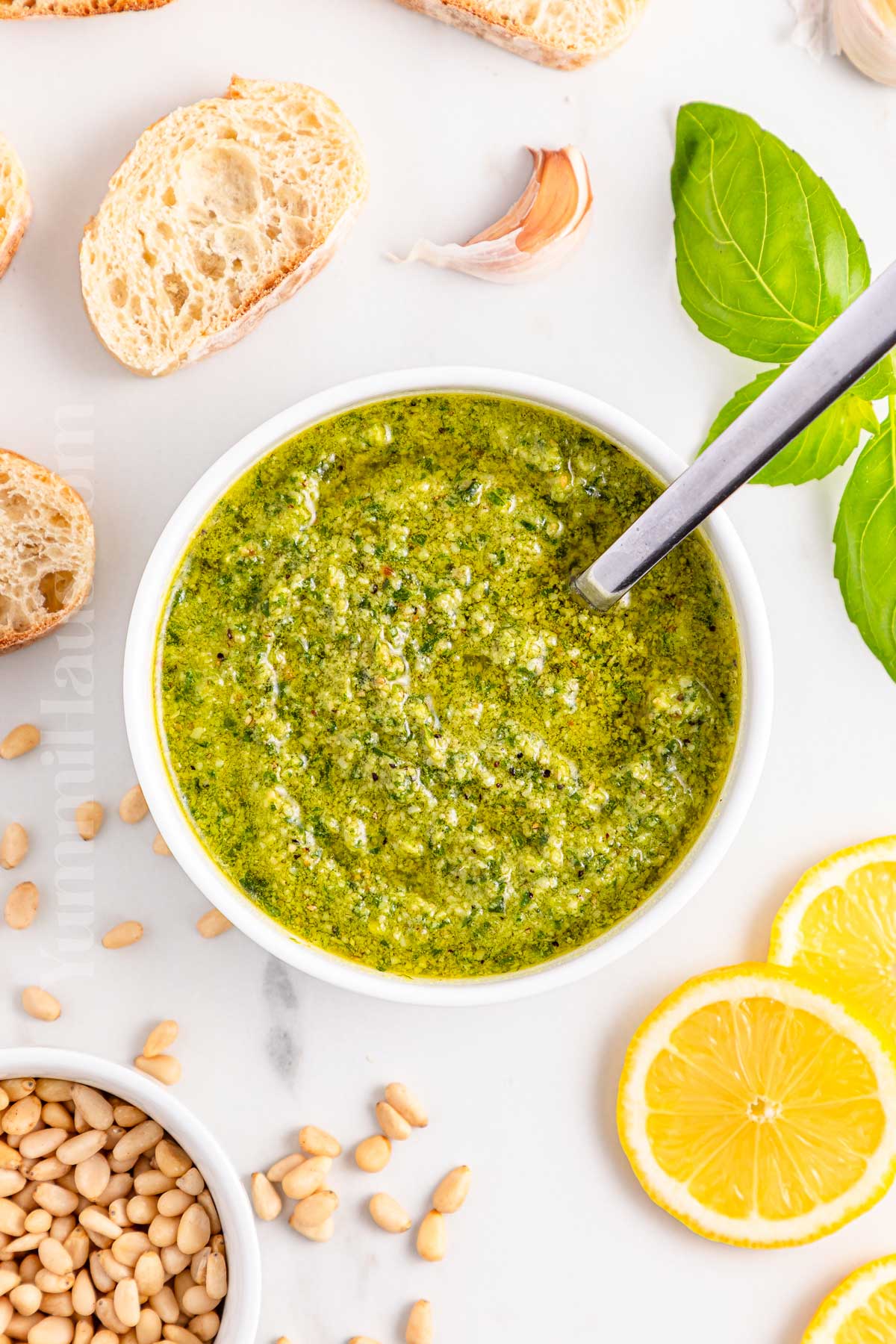
My best tip to make homemade basil pesto is to spend an extra 3 minutes toasting pine nuts before pulsing the ingredients together. It is also very important to follow the step-by-step instructions and only add the cheese as the last step.
What Is Pesto?
Pesto, which comes from the Italian word pestare, meaning “to crush,” originated in Genoa, Italy and is traditionally made with fresh basil, pine nuts, garlic, Parmesan, and olive oil.
This simple, no-cook sauce adds bright, fresh flavor to dishes and has tons of healthy fats and antioxidants.
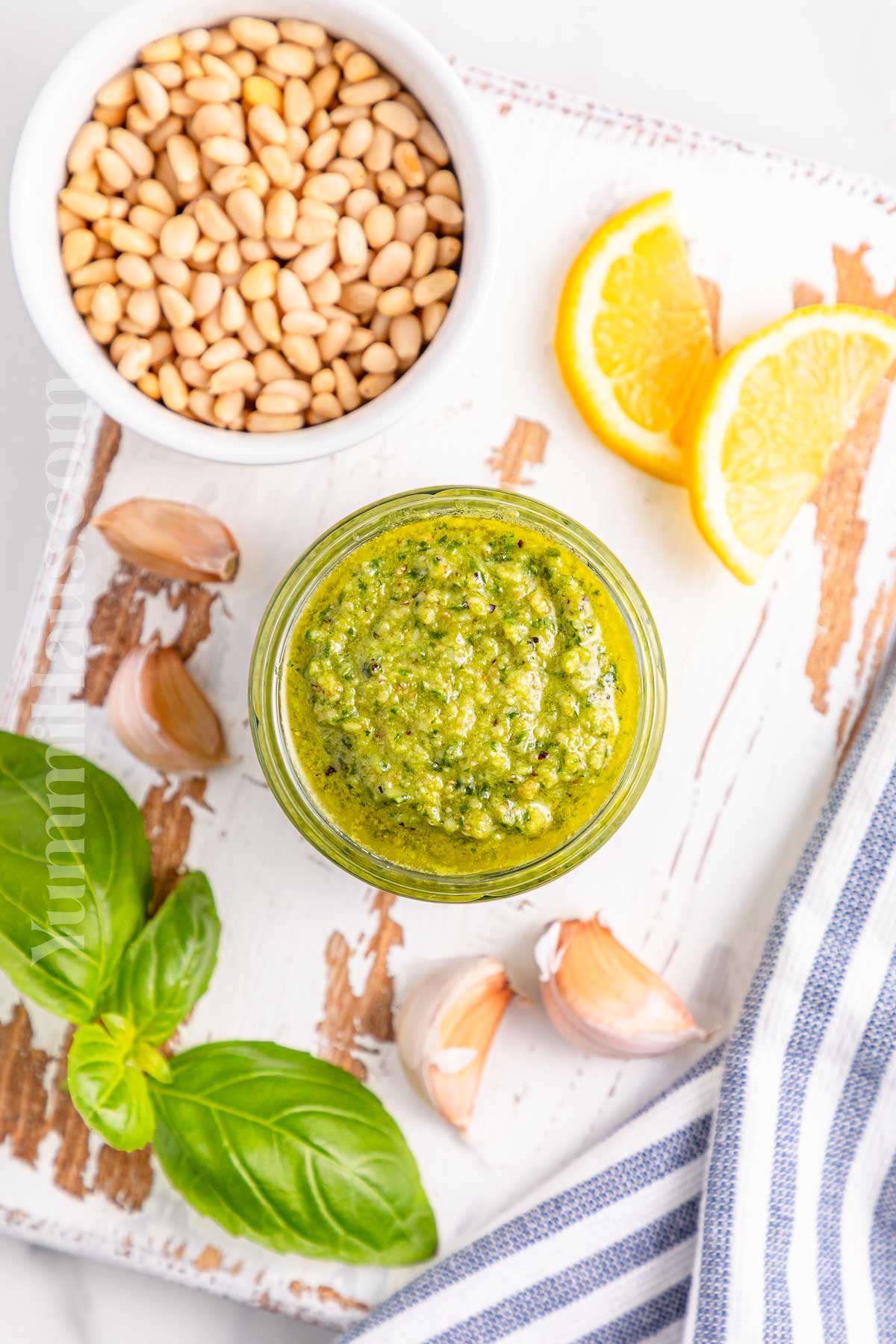
Why You’ll Love This Recipe
- You only need 15 minutes to make a small batch of basil pesto that will last you a few days.
- Delicious, versatile sauce that will quickly become your pantry staple and can elevate any dish you will quickly throw together on busy weeknights.
- Even more accessible if you grow a few basil plants in your garden or window!
- Fresh flavors of this vibrant sauce will forever push aside all the store-bought sauces. Sounds too good to be true, but just trust me on this one.
Ingredients Notes
Check nutritional information and exact quantities at the recipe card at the bottom of this page.
- Pine nuts. Toasted or raw pine nuts can be used. Toasted nuts add even more nutty flavor. I love pine nuts; they are so buttery, rich, and contain so much healthy oil!
- Fresh basil leaves add lots of flavor and bright green color to the pesto. Pick smaller leaves with no black spots. Use cold water to wash basil and don’t soak it.
- Lemon is used to make lemon juice fresh, and some lemon zest is grated, too.
- Garlic
- Extra virgin olive oil. We need a good quality oil, as it can really affect the flavor profile.
- Parmesan cheese. Make sure to buy a block and grate it fresh for making the sauce. Use a fine grater. If you’re vegan, skip the cheese or use nutritional yeast.
- Salt and black pepper, to taste
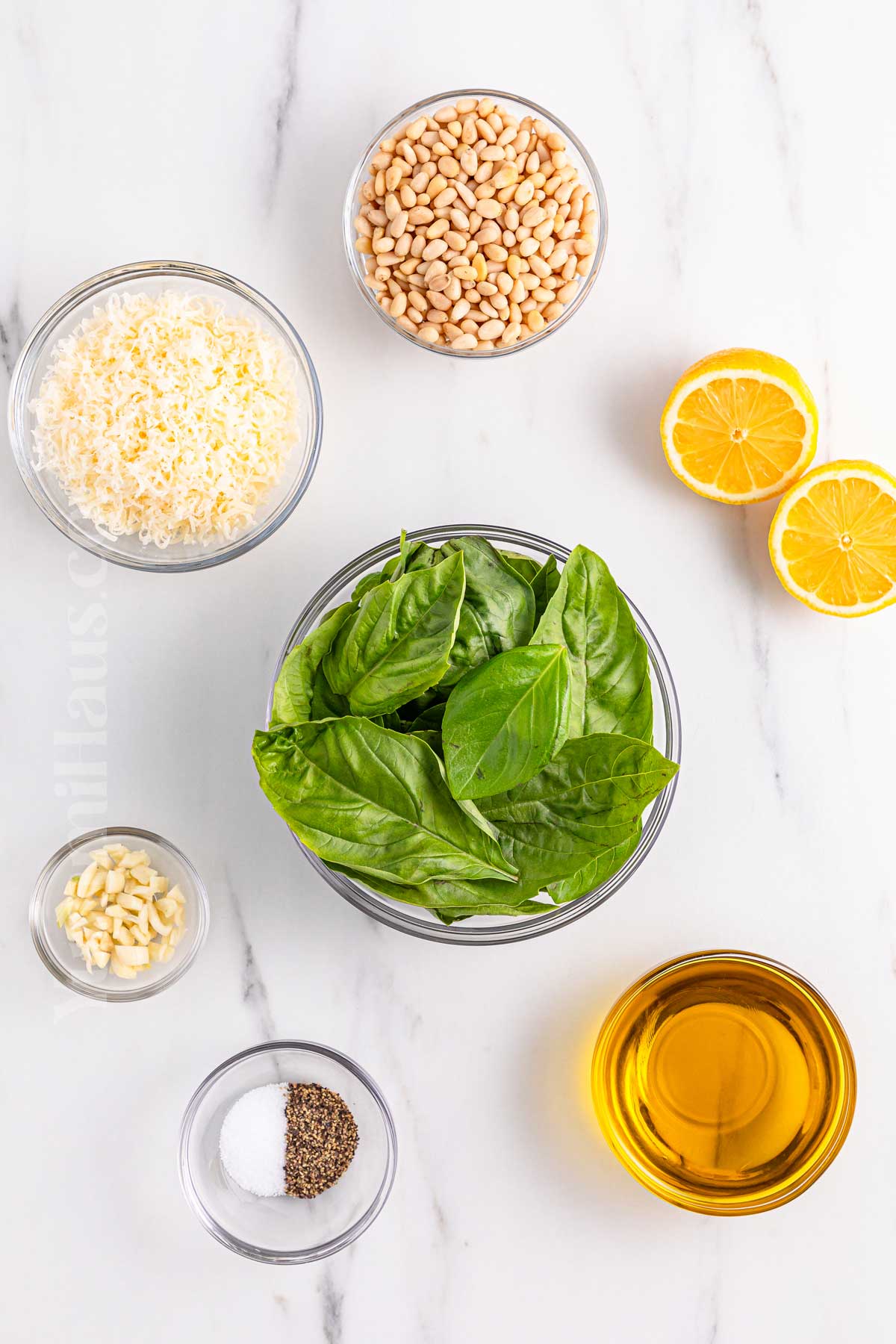
Kitchen Equipment
- Food processor
- Microplane or cheese grater
How To Make Pesto Sauce
1: Toast Pine Nuts (Optional)
- Toast the pine nuts in a medium skillet over medium-low heat, stirring frequently until golden brown for about 3-4 minutes. Don’t get distracted, as they can burn quickly.
- Remove from the heat. Set aside to cool for at least 5 minutes.
- You can also toast pine nuts in the oven at 325F until lightly golden, but it is harder to control them there.
2: Pulse Pesto Base
- Once cooled, combine the toasted pine nuts, basil, a squeeze of lemon juice, lemon zest, and finely chopped garlic in the bowl of a food processor.
- Pulse for 5-10 seconds at a time until everything is chopped into small pieces.
3: Add Oil
Turn the food processor on low and slowly pour in the olive oil while it is processing to allow it to emulsify. Turn it off and scrape down the sides.
4: Add Parmesan Cheese
Pulse in the parmesan, salt, and pepper.
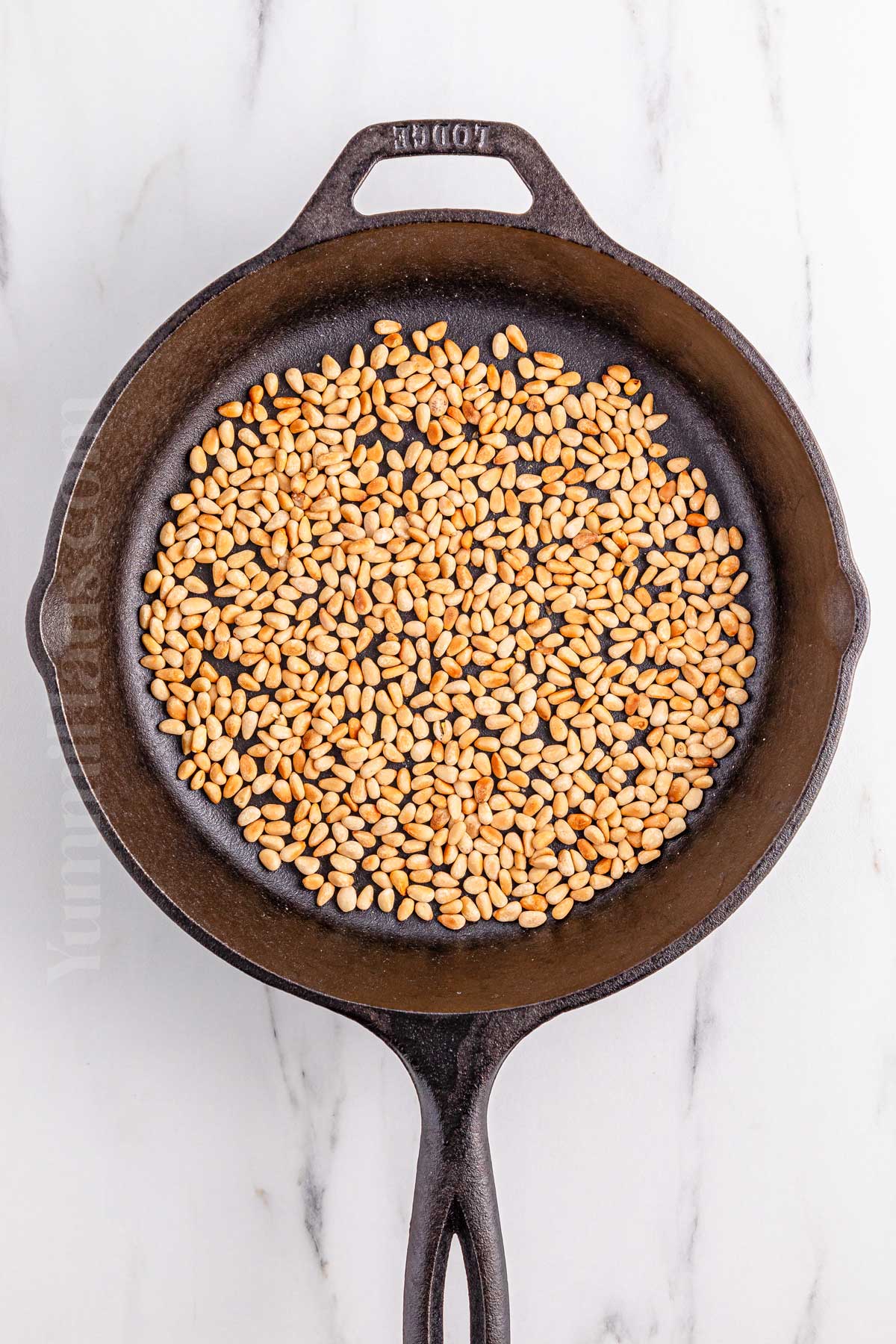
Where Can I Use Basil Pesto Sauce?
Serve homemade pesto sauce over steak, chicken, shrimp, or fish, or enjoy as a sauce in pasta salad, pesto pasta, gnocchi, or as a spread for sandwiches, or over bread.
Pesto pairs well with tomatoes, fresh herbs, eggs, fresh mozzarella cheese, and roasted vegetables.
Pesto with a thinner consistency can also be used as a party dip for veggie sticks and crackers.
Storage
Store basil pesto leftovers in an airtight container like a mason jar and refrigerate for up to 4 days.
You can also divide it and store it in an ice cube tray in the freezer for up to 3 months. When needed, let it thaw at room temperature.
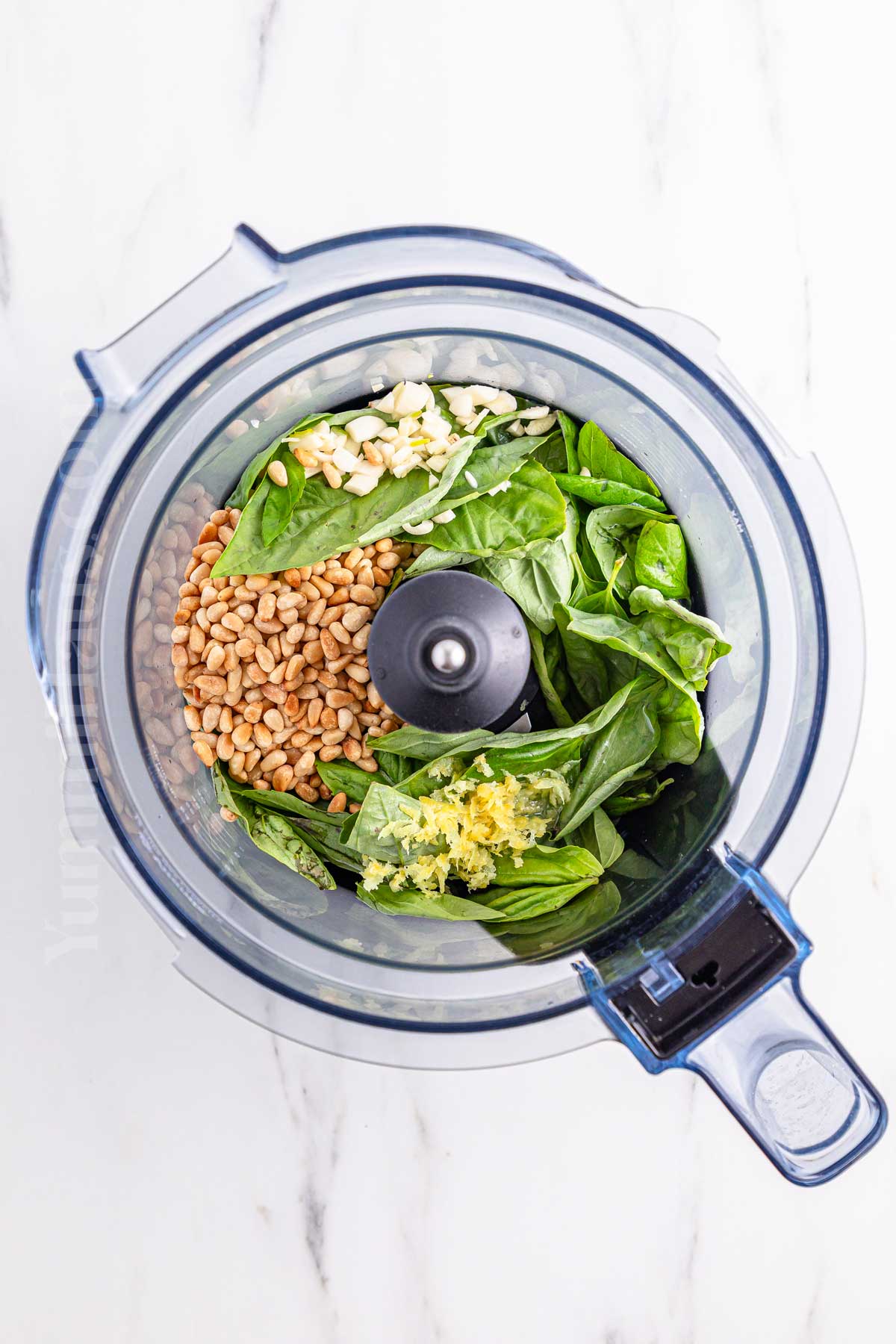
Substitutions & Pesto Variations
- Nuts. You can make walnut pesto with walnuts, or use pistachios, almonds, even sunflower seeds or pumpkin seeds (it will change the flavor significantly, of course).
- Cheese. Parmesan cheese (Parmigiano Reggiano) is the classic option, but you can use Pecorino Romano, vegetarian Parmesan cheese, Grana Padano, or cheddar cheese (least recommended!).
- Basil. You can use mint, cilantro, kale, arugula, parsley, and baby spinach alongside or instead of basil to make fresh pesto.
- Sun-dried tomato pesto. Another cool variation. You simply blend sun-dried tomatoes with basil leaves.
- Apart from salt and pepper, you can add red pepper flakes, cayenne, or paprika, too.
- Use roasted garlic to make the garlic flavor less pronounced.
- Add heavy cream to make an extra creamy sauce. It works well when you’re making pesto pasta.
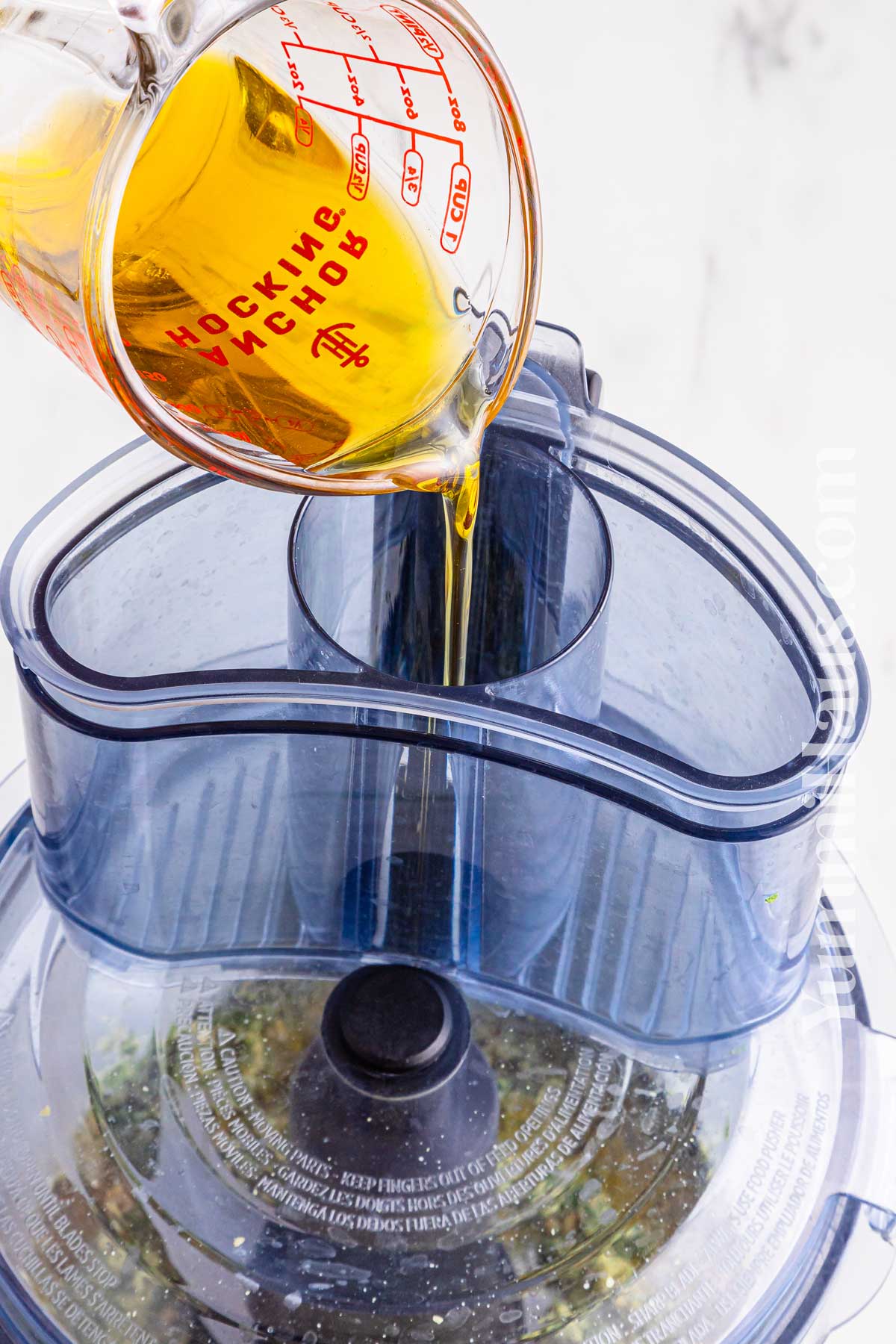
Expert Tips To Make The Best Pesto
- Add a thin layer of olive oil on top and cover with plastic wrap or place in an airtight container (like a mason jar with a lid) to slow down the oxidation process. Pesto will slowly start to turn brown when in contact with air.
- Lemon also helps to slow down the oxidation process.
- Blanching the basil can help to slow down the oxidation process and help keep the leaves green.
- For a thinner consistency and smoother pesto, add a little more olive oil.
- You can alter the ratios if you want one flavor to be more pronounced, such as more grated parmesan, more pine nuts, more garlic, or more salt and pepper.
- You can save up a few pine nuts and fresh basil leaves for serving. Use them as a garnish for a restaurant-style presentation.

If you love this sauce recipe, you’re going to love these other homemade sauces, too. Please click each link below to find the easy, printable recipe!
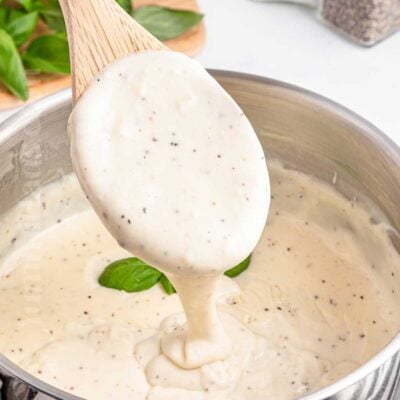
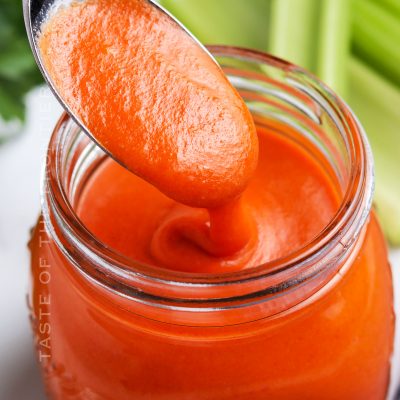

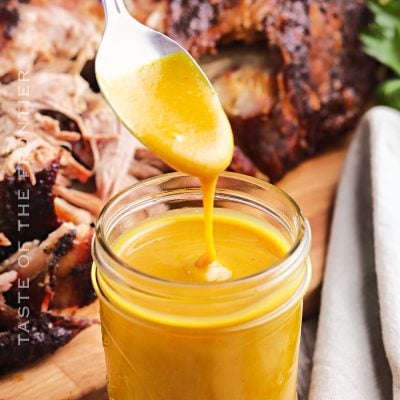
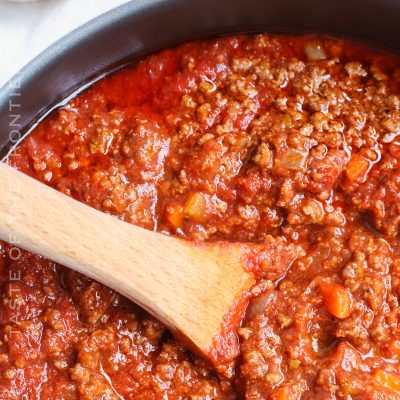
More Great Recipes with Pesto
Sheet Pan Pesto Chicken Dinner
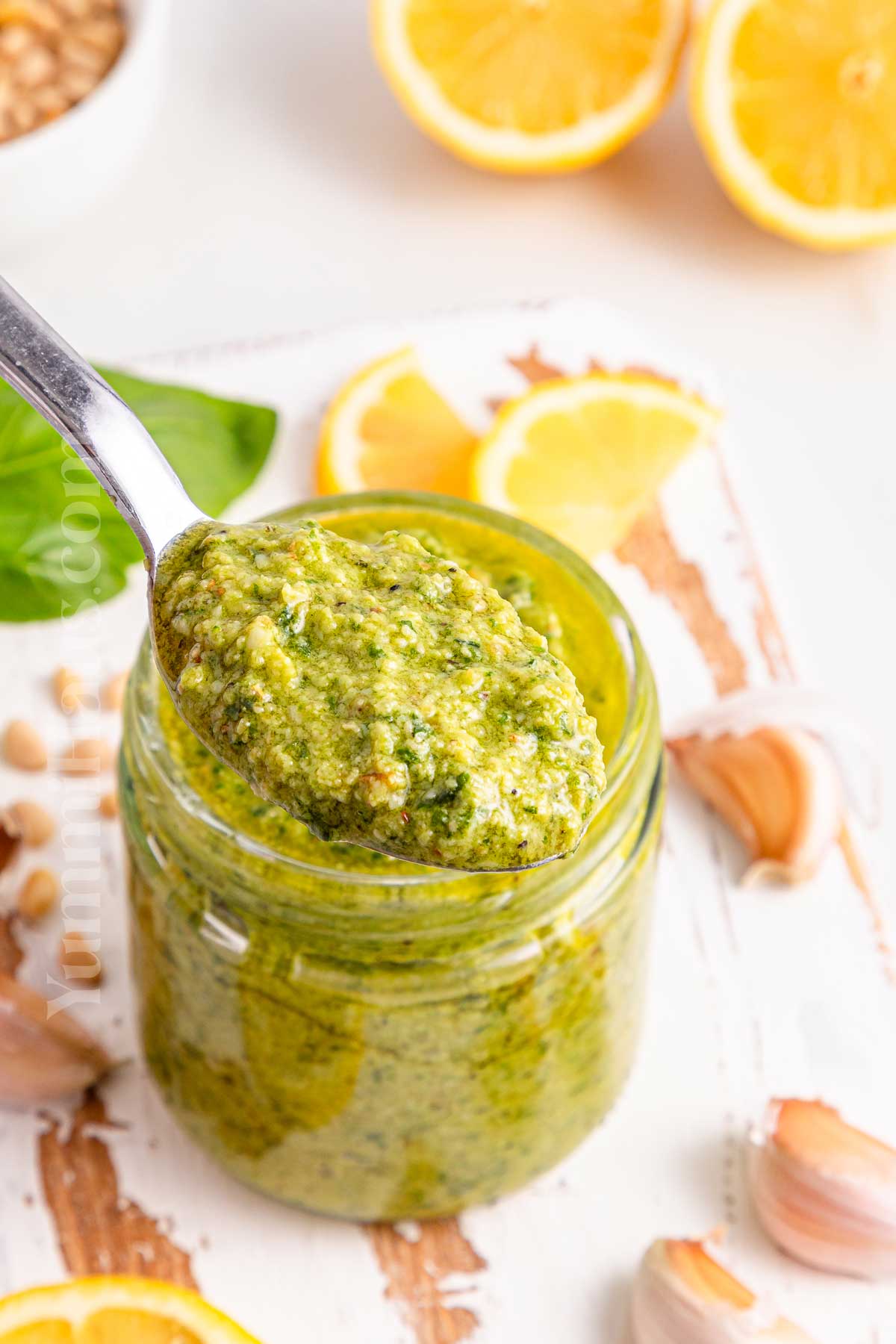
CONNECT WITH YUMMI HAUS!
Be sure to follow me on my social media, so you never miss a post!
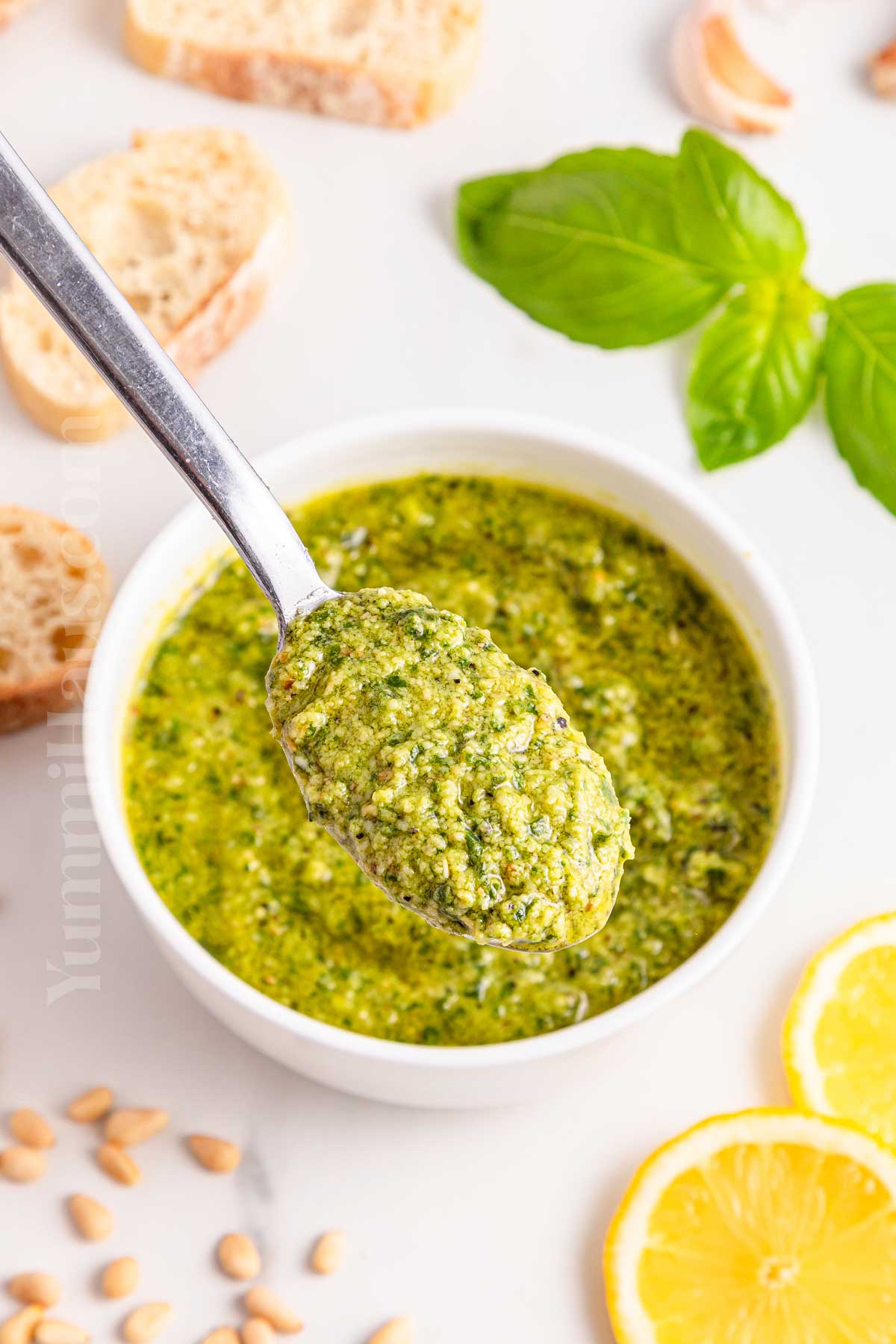
Pesto Sauce Recipe for Pasta
Ingredients
- ½ cup pine nuts raw
- 2 cups basil leaves packed
- 2 tablespoons lemon juice fresh-squeezed
- 1 teaspoon lemon zest
- 2 garlic cloves chopped
- ½ cup olive oil extra virgin
- ½ cup Parmesan cheese – freshly, finely grated
Salt and pepper, to taste
Serving suggestions: over steak, chicken, or fish, or enjoy as a sauce in pasta salad, pasta, or as a spread for sandwiches, or over bread
Instructions
- Toast the pine nuts in a medium skillet over medium-low heat, stirring frequently until golden brown for about 3-4 minutes. Don’t get distracted, they can bury quickly.
- Remove from the heat. Set aside to cool for at least 5 minutes.
- Once cooled, combine the toasted pine nuts, basil, lemon juice, lemon zest, and garlic in the food processor. Pulse for 5-10 seconds at a time until everything is chopped into small pieces.
- Turn the food processor on low and slowly pour in the olive oil while it is processing to allow it to emulsify. Turn it off and scrape down the sides.
- Pulse in the parmesan, salt, and pepper.
This can be used with steak, chicken, fish, as a sauce in pasta salad, pasta, or as a spread for sandwiches or over crostini/bread.
Notes
- Raw pine nuts can be used.
- Add a thin layer of olive oil on top and cover with plastic wrap or place in an airtight container (like a mason jar with lid) to slow down the oxidation process. Pesto will slowly start to turn brown when in contact with air.
- Lemon helps to slow down the oxidation process.
- Blanching the basil can help to slow down the oxidation process and help keep the leaves green.
- For a thinner consistency, add a little more olive oil.
- You can alter the ratios if you want one ingredient to be more pronounced, such as more grated parmesan, more pine nuts, more garlic, or more salt and pepper.
Store leftovers in an airtight container like a mason jar and refrigerate for up to 4 days.
Equipment
- Food Processor
Nutrition
Nutritional information for the recipe is provided as a courtesy and is approximate. Please double-check with your own dietary calculator for the best accuracy. We at Yummi Haus cannot guarantee the accuracy of the nutritional information given for any recipe on this site.

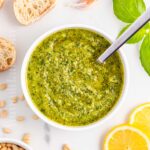
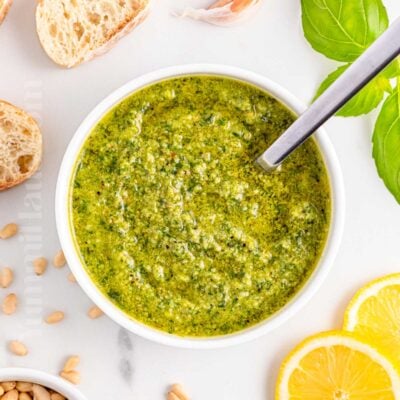






Share Your Thoughts